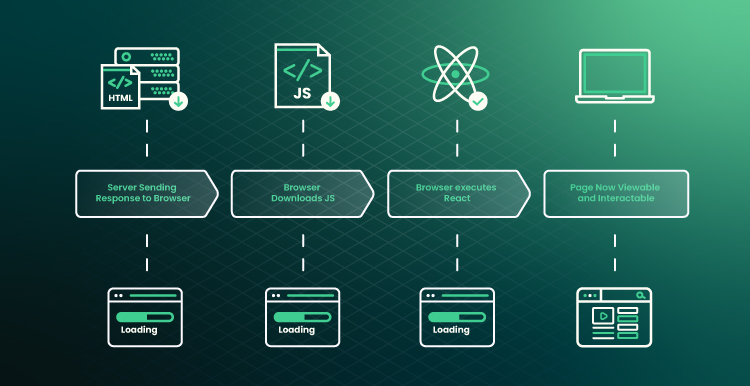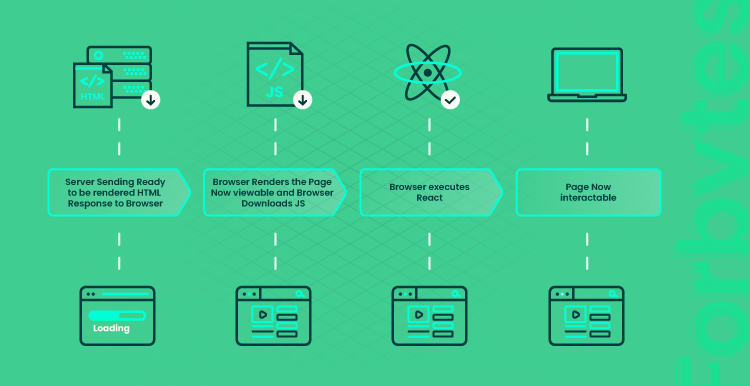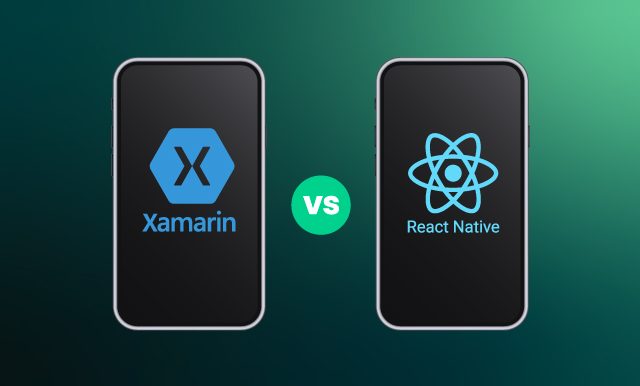Server-side rendering, or SSR, is a technique for rendering single-page applications (SPAs) on the server rather than in the client’s browser. This approach provides many benefits for an app, and we’ll discuss them in this article. We’ll also reveal how React SSR works and what tools you need to integrate it into a React app.
Let’s start.
What is React SSR (Server-Side Rendering)?
Server-side rendering is a method of website construction that improves site speed by sending HTML code to the browser in advance. This allows the browser to display content immediately without waiting for JavaScript to be downloaded and executed. SSR also reduces the amount of data that needs to be downloaded, as only the necessary HTML is sent to the browser.
As a result, SSR can significantly improve the loading speed of websites, especially on mobile devices, thus improving the user experience.
Client-Side Rendering vs. Server-Side Rendering
Regarding web development, there are two main ways to render a page: client-side rendering and server-side rendering. Both methods have their own advantages and disadvantages, so it’s crucial to understand the difference before choosing which one to use.
Client-side rendering is the process of rendering a page on the client device, typically using JavaScript. This means that all the necessary code is downloaded to the client before the page is rendered. One advantage of this approach is that it can be faster since the client doesn’t have to wait for the server to generate the HTML. However, it can also be less reliable because JavaScript can sometimes be disabled or not supported by specific browsers. Because all the code is downloaded at once, CSR can result in larger file sizes.

Server-side rendering, on the other hand, refers to the process of generating HTML on the server and then sending it down to the client. This approach has the benefit of being more compatible with different browsers as it doesn’t rely on JavaScript. Additionally, because HTML is generated on the server, file sizes are typically smaller.
Server-side rendering can be slower than client-side rendering since the server has to do more work upfront. Also, it can be more challenging to implement dynamic content with SSR.

The decision of whether to use client-side or server-side rendering depends on your specific needs and requirements. If speed and compatibility are your main concerns, then client-side rendering may be the better option. However, if you need smaller file sizes or want to avoid JavaScript altogether, then server-side rendering may be a better fit.
Ultimately, it’s important to choose the approach that makes sense for your particular project.
Overview of Single-Page Apps
A web application or website that just loads the current page from the server to interact with the user is known as a single-page application (SPA). This strategy prevents the user experience from being interrupted when switching between subsequent pages, resulting in a user interface that is more responsive and fluid. SPAs are typically built using Ajax, HTML5, and CSS3 and may use various frameworks such as AngularJS, React, Vue.js, and others.
One advantage of SPAs is that they can provide a more responsive and engaging user experience than traditional web applications. By avoiding full-page reloads, SPAs can respond to user interactions more quickly and smoothly. This can make for a more enjoyable and efficient user experience, especially on mobile devices where network speeds may be slower. Also, because SPAs only need to load a single HTML page upfront, they can load faster than traditional web applications.
However, there are also some disadvantages of building SPAs. One challenge is that search engines may have difficulty indexing the content of SPAs since the dynamic nature of the content can make it difficult for crawlers to access. Additionally, since SPAs rely heavily on JavaScript, there is a potential for issues if users have disabled JavaScript in their browsers or are using an older browser that doesn’t support modern JavaScript features.
When to Use Server-Side Rendering?
Here are several situations where SSR may be the best choice:
- Performance is critical. SSR can help improve the performance of your application by reducing the number of round-trips to the server.
- You need to support legacy browsers. Legacy browsers may not support CSR, so SSR may be necessary to ensure compatibility.
- You need to generate static content. If you need to generate static content (e.g., for a blog), SSR may be the simplest solution.
- The network is slow.
- To render the page with data, the server has enough resources available. Note that Node is single-threaded, so intensive processing may delay inbound requests.
- Before data appears, there is only a brief pause. In other words, visitors may not notice or detect the brief flash of a blank page while it loaded quickly.
- The primary script is extensive and takes a while to load. The initial request for our SSR page is for a rendered page containing data. There is no delay in sending this request, contrary to the CSR situation. In CSR, an app only sends an additional request once the primary scripts have fully loaded.
- SEO is crucial. Googlebot and other search engine bots can correctly index an SSR page.
Note that SSR generally requires more resources than CSR, but it can be cached and delivered more quickly. SSR also stays on guard of your web app security, as the HTML is not exposed to the client until it is fully rendered.
Pros of Rendering React on the Server
While there are some potential drawbacks to using SSR, such as increased complexity and server costs, the benefits far outweigh the negatives.
There are numerous pros to using SSR in a React application.
Better Search Engine Indexability
When a page is rendered on the server, the HTML code contains all the relevant information that a search engine needs to index the page. In contrast, the HTML code only contains placeholder information when a page is rendered on the client side. As a result, search engines may have difficulty indexing pages built with CSR. This can lead to lower search engine rankings and traffic levels.
High-Speed Initial Page Load
The necessary HTML and CSS can be generated upfront by rendering the page on the server before sending it to the client. This means that the browser can start rendering the page as soon as it receives the HTML without waiting for additional resources to finish loading. In contrast, with client-side rendering, the browser must first download and execute JavaScript before it can start rendering the page. For sites with large amounts of content or complex interaction patterns, this can lead to significant delays in page load times.
Faster Largest Contentful Paint (LCP)
One of Google’s three Core Web Vitals, which are now part of its search ranking algorithm, is Largest Contentful Paint. In terms of both desktop and mobile searches, it’s also the one that’s most difficult to pass.
SSR allows the browser to start loading content immediately without waiting for the JavaScript code to be downloaded and executed. In addition, SSR can also help improve other performance metrics such as First Input Delay (FID) and Time-to-Interactive (TTI). As a result, SSR is a valuable tool for any website looking to improve its performance.
Lower Cumulative Layout Shift (CLS)
CLS is a measure of how much content shifts around on a page as it loads, and it can be a major source of user frustration. By rendering the initial HTML on the server, SSR ensures that the layout remains stable as additional resources are loaded. This can help create a smoother and more responsive user experience, which is especially important for users on slow or unreliable connections.
Effortless Social Media Indexing
Regarding social media indexing, SSR has a clear advantage. Because the content is fully rendered on the server before it is even sent to the client, pages that use SSR are more likely to be correctly indexed by social media platforms. This can sometimes be an issue with CSR, as some social media crawlers cannot execute JavaScript. As a result, pages that rely on client-side rendering may not be properly indexed by social media platforms.
Cons of Rendering React on the Server
One potential drawback of rendering React on the server is that it can be CPU-intensive, especially if your application is heavy on graphics or animations. This can lead to longer page-load times and higher server costs. Additionally, SSR can make your application more difficult to scale, as you will need to ensure that your server has enough resources to handle the increased demand. Finally, some developers believe that CSR provides a better user experience, allowing for more interactivity and faster page loads.
How Server-Side Rendering Works
So, SSR involves sending HTML code to the client that the browser can immediately render. This way, servers can provide clients with the information they need in a format readily displayed by their browsers.
The server-side rendering process involves the following steps:
- Client’s HTTP request: The first step is to receive the request from the client. The browser opens an HTTP connection to the server when the user types the URL into the address bar, after which it requests the HTML content from the server.
- Data fetching: Next, the server will determine what data is needed to fulfill the request. For example, if the client has requested a specific page on a website, the server will need to retrieve the relevant HTML code and any associated resources (such as images or CSS files).
- Server-side pre-rendering: Once all the necessary data has been gathered, the server will generate the HTML code for the response.
- Server’s HTTP response: The HTML file is delivered to the client by the server.
- Page load and rendering: The browser will render the received HTML code, displaying the requested page.
- Hydration: The client processes the HTML’s embedded JavaScript files, downloads them, and attaches event listeners to the components. Another name for this process is hydration or rehydration.
By breaking down the process into these distinct steps, you can create a more efficient and responsive user experience. By optimizing each of these steps, you can further improve performance and create an even smoother user experience.
Server-Side Rendering Frameworks and Tools
There are several different frameworks and tools available for SSR, including React, Angular, Vue, and Node.js. Each of these frameworks has its own strengths and weaknesses, so it’s important to choose one that’s well suited to your particular project. In addition, you’ll need to consider factors like performance, security, and SEO when making your decision.
Next.js
Next.js uses JavaScript and React to automatically generate HTML pages on the server, which leads to a faster and more SEO-friendly website. The generated HTML pages are then sent to the browser, where they are hydrated with React components. Next.js is also bundled with webpack, so you can use all the features of React, including JSX and CSS-in-JS. In addition, Next.js provides a simple way to deploy your application to the cloud, making it easy to scale your application as needed.
Razzle
Razzle takes advantage of the fact that React components are self-contained and can be rendered independently. This allows Razzle to prerender each component on the server and then hydrate the static markup on the client. This results in a faster, more responsive user experience. Razzle is also easy to use, with a simple configuration file that makes it easy to start. It comes with a development server that provides hot reloading and error reporting.
Remix
Remix is a React SSR framework that allows developers to create digital products that are both fast and reliable. Using the SSR approach, Remix ensures that your content is fully loaded before sending it to the user’s browser. This means that users will never have to wait for pages to load, even when they are on a slow Internet connection. In addition, Remix provides a set of tools that make it easy to create real-time applications.
Final Word
You’ve created a React app, and it’s looking great so far. Now you’re wondering how to take it to the next level, right? At Forbytes, we help companies build new digital products, improve their business strategies, and bring innovation to their domain. We have a team of expert developers, designers, and strategists who can help you take your business to the next level.
Contact us today if you need help with your digital transformation. We’ll work with you to understand your needs and develop a custom solution that fits your budget and timeline. Let us show you what we can do.

Our Engineers
Can Help
Are you ready to discover all benefits of running a business in the digital era?

Our Engineers
Can Help
Are you ready to discover all benefits of running a business in the digital era?







